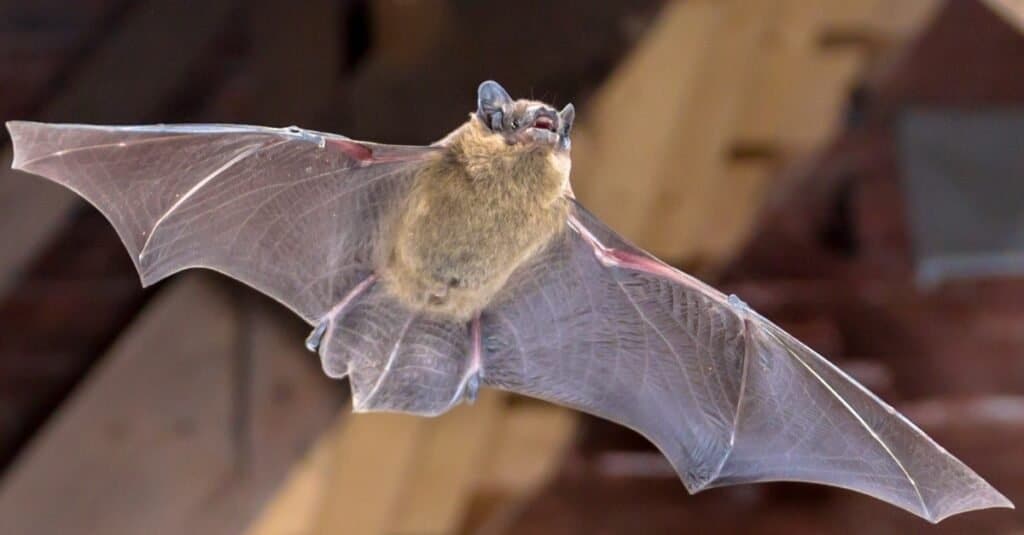The metabolic rate is defined as the rate at which metabolism occurs in living organisms.

Hibernation involves an extreme reduction in metabolic rate, heart rate, and respiratory rate that allows a bat to survive long periods of time without food.
©Rudmer Zwerver/Shutterstock.com
Summary
There are many different processes that take place in living organisms at any given time at a cellular level. These processes are not clearly visible and consist of chemical and microscopic metabolic body functions that are vital to our survival. These functions include respiration, enzyme activity, blood circulation, and even hormonal signals. They are responsible for how our bodies convert and use energy during biochemical processes.
The metabolic rate refers to the amount of energy used by any living organism during a certain time period. It can vary depending on the season and activities that the living organism is performing. The metabolic rate can be measured in different ways, but usually by methods such as the amount of oxygen used, food consumption, and energy lost as heat. Most living organisms have a metabolic rate that is considered normal for the species, but it is subject to change and variation.
Both endotherms (warm-blooded) and ectotherms (cold-blooded) animals have a measurable metabolic rate. Generally, any living organism from microscopic bacteria to a tall tree undergo metabolic processes that require energy use and conversion.
Different Types of Metabolic Rates in Animals
There are around three different types of metabolic rates which we will discuss below.
Basal Metabolic Rate (BMR)
The minimum metabolic rate at which living organisms perform basic bodily functions. This includes things like cell production, blood circulation, heat regulation, and even breathing during a resting state.
Endotherms tend to have a higher metabolic rate since they need to constantly thermoregulate. Whereas an ectotherms body temperature depends on their external environment. So, if the temperature is low, an ectotherm is going to have a lower metabolic rate than an endotherm.
The size of a living organism can also influence their basal metabolic rate since it is higher per unit of mass in small animals than in large animals. For example, an elephant is going to have a lower basal metabolic rate than a tiny mouse. This is only if you were to compare the animal’s surface-to-mass ratio and not as a whole. The elephant typically has much more tissue to metabolize than a mouse.
Standard Metabolic Rate (SMR)
Standard metabolic rate refers to the minimum metabolic rate that is needed by a living organism to sustain its life at a certain temperature. This is measured in ectothermic animals like snakes or fish which cannot thermoregulate on their own. Instead, they rely on external factors to influence their internal temperature. Their bodies use less energy because they do not need to constantly maintain their body temperature like endotherms do.
Resting Metabolic Rate (RMR)
The resting metabolic rate refers to the amount of energy living organisms use at complete rest. It is often confused with basal metabolic rate, but the difference is that the basal metabolic rate is only the minimum energy used, whereas the resting metabolic rate is the actual amount of energy living organisms use when resting.
Different Animal Metabolic Rates
It is true that some of the smallest animals have the highest metabolic rates per unit of mass. They have very fast metabolisms and need to eat their body weight in food, or they can starve quickly. Their small bodies also use a lot of energy to perform everyday functions such as heat regulation and they need more oxygen delivered to their body’s tissue to function.
Animals with high metabolic rates include:
- Shrews
- Hummingbirds
- Mice
- Rats
- Squirrel
- Bats
Larger animals generally have a lower metabolic rate than smaller animals. This is simply because they lose less energy per unit of mass than smaller animals. Therefore, they require less energy to replace that lost energy.
Animals with low metabolic rates include:
- Sloths
- Horse
- Hippopotamus
Metabolic Rate in Ectotherms
The metabolic rate for endotherms is different than ectotherms. This is because an ectotherms metabolic rate is influenced by temperature. So, the higher the temperature is, the more their metabolic rate increases. Furthermore, the lower the temperature, the slower an ectotherm’s metabolic rate may be.
Although endotherms will raise their metabolic rate when they are experiencing cold temperatures, an ectotherm cannot do this. Instead, they will lower their metabolic rate if the temperature is low.
Tortoises are an example of an ectotherm with a low metabolic rate. They do not need to use energy to thermoregulate themselves and can survive without food for much longer than most endoderms. Furthermore, tortoises and many other ectothermic reptiles will either hibernate (during winter) or aestivate (during summer).

Tortoises will enter a state of hibernation in very low temperatures. This allows them to conserve energy and their metabolism is reduced.
©iStock.com/Remus86
When a tortoise is hibernating, their metabolic rate drops very low to adapt to the cooler temperatures and conserve energy. This allows them to survive during colder months that would otherwise cause them to die. When tortoises are aestivating during hot conditions or droughts, they have a low metabolic rate to conserve energy and prevent dehydration.



